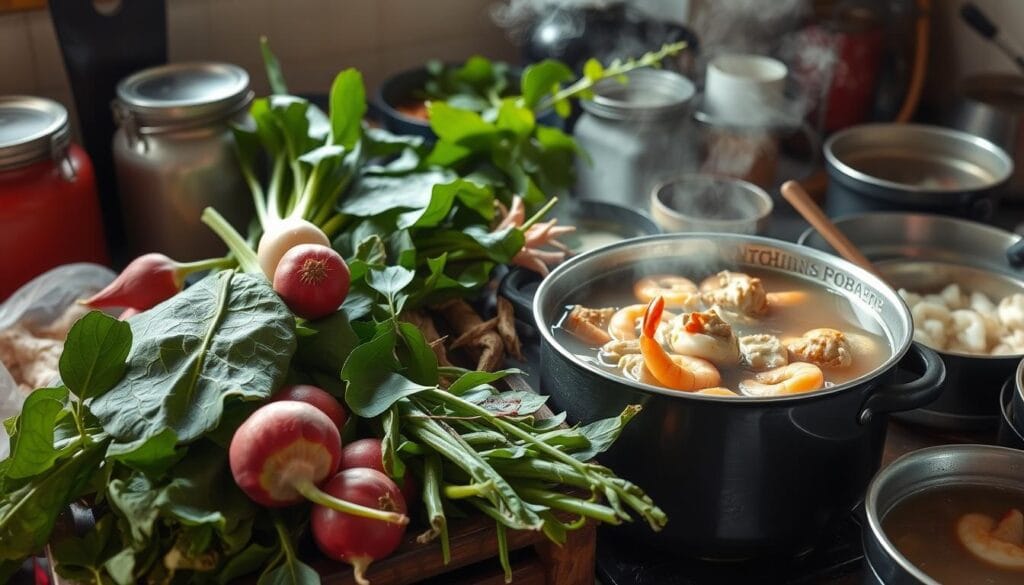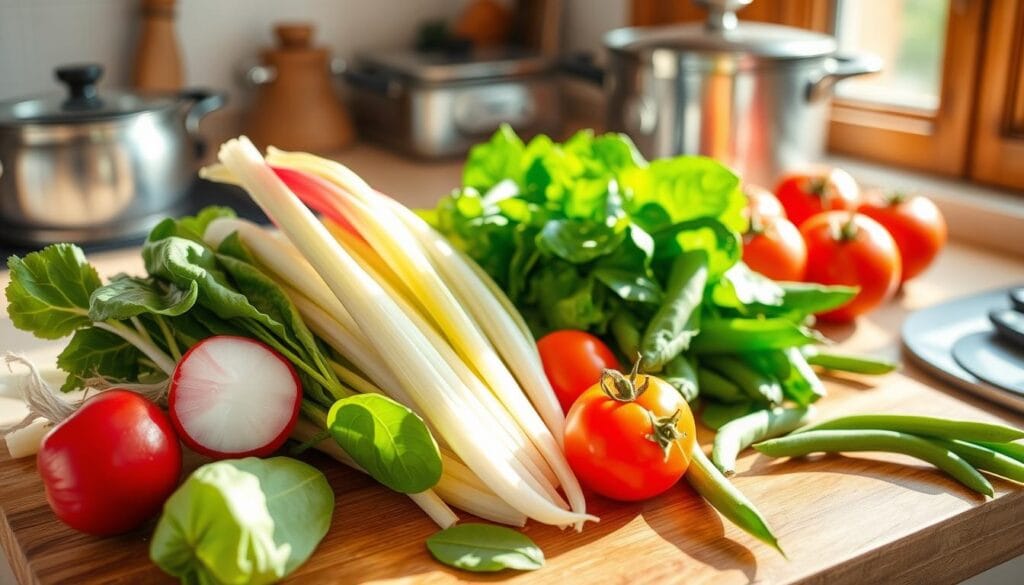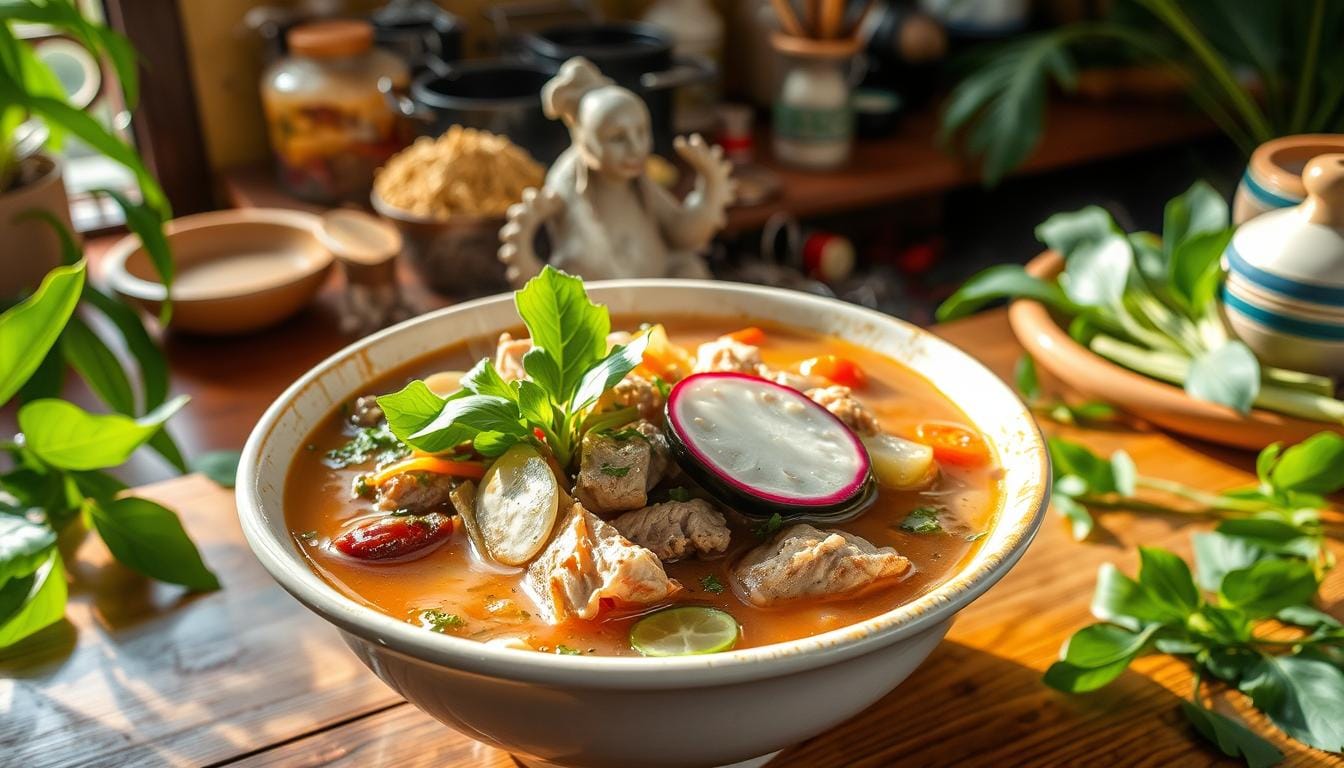Imagine a warm bowl that tells a story of tradition, comfort, and vibrant flavors. The sinigang recipe is more than just a meal. It’s a culinary journey through the heart of Filipino cuisine. In 2021, TasteAtlas named it the best vegetable soup in the world.
This iconic dish brings together a perfect balance of sourness and savory depth. It will transport your taste buds to the Philippines.
Your adventure into Filipino sinigang begins with a rich, tangy broth. It captures the essence of home cooking. Each spoonful represents generations of culinary tradition.
It blends fresh vegetables, tender proteins, and a distinctive souring agent. This makes the soup truly unique. Whether you’re a curious food lover or someone seeking to explore authentic international flavors, this sinigang recipe promises an unforgettable dining experience.
Preparing sinigang isn’t just about following a recipe. It’s about connecting with a cultural narrative. The dish’s versatility allows you to experiment with different proteins, from classic pork to seafood or even vegetarian options.
Get ready to dive into a cooking experience that goes beyond mere ingredients. It transforms your kitchen into a gateway to Filipino culinary heritage.
Table of Contents
Understanding the Cultural Significance of Sinigang
Sinigang is more than a sour soup in Filipino cuisine. It’s a dish that shows the creativity and adaptability of Filipino cooking. It’s deeply rooted in Philippine cultural heritage.
The name sinigang comes from the Tagalog verb sigang, which means “to stew”. This shows the dish’s cooking method and its importance in Filipino homes.
Origins and Historical Background
Sinigang was made before colonial times. It started as a way to use local ingredients and preserve food. This sour soup shows how Filipinos turned simple ingredients into a tasty meal.
- Indigenous origins before colonization
- Reflects local cooking traditions
- Utilizes abundant local ingredients
Regional Variations Across Philippines
Every region in the Philippines has its own sinigang. Coastal areas use seafood, while inland areas use pork or beef. This shows the country’s diverse food scene.
Cultural Impact on Filipino Dining
Sinigang is more than a meal; it’s a symbol of family and community. It’s made in big batches for gatherings. It shows hospitality and shared moments.
“Sinigang is not just food; it’s a celebration of Filipino culture on a plate.” – Filipino Culinary Expert
Sinigang is key in keeping Filipino traditions alive. It’s served at family meals and special events. It’s a way to honor Filipino culinary heritage.
Essential Ingredients for Authentic Sinigang
Making a real tamarind soup needs the right mix of ingredients. This mix adds depth and complexity to this favorite Filipino dish. Starting your journey in traditional Filipino cuisine means knowing the key parts that make sinigang special.
The heart of a great sinigang recipe is choosing fresh, top-quality ingredients. Here are the must-haves:
- Protein options:
- Pork belly
- Beef
- Shrimp
- Fish
- Vegetables:
- Water spinach (kangkong)
- String beans
- Eggplant
- Radish
- Tomatoes
- Green chili peppers
The key to any tamarind soup is the souring agent. Young tamarind gives the soup its tangy taste. Use fresh tamarind pulp or a tamarind stew mix for that real flavor.
“The magic of sinigang lies in its perfect balance of sour, savory, and fresh flavors.” – Filipino Culinary Experts
Here are some pro tips for your sinigang ingredients:
– Pick fresh veggies
– Choose the best protein
– Use ripe tamarind for the best taste
– Try different proteins to find your favorite
Traditional Souring Agents and Their Characteristics
In Filipino cuisine, making the perfect tamarind soup is all about choosing the right souring agent. Fans of sour soups know that the secret to a true sinigang is finding the right mix of tangy flavors.
Tamarind (sampaloc) is the top choice for souring in traditional sinigang. It offers a mix of tartness and sweetness that makes the classic Filipino sour soup special.
Tamarind: The Primary Souring Agent
About 90% of traditional sinigang recipes use tamarind as the main souring ingredient. Fresh tamarind gives the best flavor. But, tamarind-flavored seasoning mixes are also getting popular.
Exploring Alternative Souring Fruits
- Green Mangoes: Offer a crisp, tangy flavor
- Guava: Provides a tropical freshness
- Calamansi: Adds a citrusy sweetness
- Bilimbi (Kamias): Delivers an intense sour punch
Selecting Your Perfect Souring Agent
When picking a souring agent for your sinigang, think about these things:
- Availability of fresh ingredients
- Desired intensity of sourness
- Personal flavor preferences
- Seasonal ingredient accessibility
“The secret to an amazing sinigang is finding the perfect balance of sourness that dances on your palate.” – Filipino Culinary Tradition
Modern cooking has brought new souring agents like strawberries and watermelon. This shows that sinigang is still evolving but keeps its traditional taste.
Step-by-Step Sinigang Recipe

Making an authentic sinigang recipe needs focus and love for Filipino food. This guide will help you make a tasty traditional sinigang. It will show you how to bring the true taste of Filipino home cooking to your table.
First, gather these important ingredients:
- 1.5 lbs pork belly
- 1 roma tomato
- Assorted vegetables (taro, white radish, Chinese eggplant, leafy greens)
- 40g Knorr Sinigang sa Sampaloc Mix
- 5 cups water
Now, let’s start your sinigang recipe with these key steps:
- Prepare the meat: Brown the pork belly in a large pot with 2 cups of cooking oil
- Add chopped tomatoes and sauté until softened
- Pour in 5 cups of water and bring to a boil
- Reduce heat and simmer pork for approximately 45 minutes
- Add Knorr Sinigang mix for authentic sourness
In the last 10-15 minutes, add your vegetables step by step. Start with harder veggies like taro and white radish. Then, add softer ones like eggplant and string beans. Finally, add leafy greens for just 1-2 minutes to keep their color and nutrients.
Pro tip: Adjust the sourness by adding extra tamarind paste to suit your taste preferences.
Your sinigang is done when the pork is tender and the veggies are just right. This recipe makes 2-3 servings. You can keep it in an airtight container for 2-3 days.
Protein Options and Variations
Sinigang is a versatile dish that lets you try many protein choices. You can pick from meat, seafood, or even plant-based options. This way, you can make the dish your own, based on what you like and need.
Pork Sinigang: A Classic Favorite
Pork sinigang is a top pick for many. It uses different cuts of pork, like:
- Pork belly
- Pork shoulder
- Pork ribs
- Neck bones
Seafood Sinigang Delights
For a lighter option, try fish or shrimp sinigang. You can use:
- Milkfish (bangus)
- Fresh or frozen shrimp
- Firm white fish varieties
Vegetarian Protein Adaptations
Want a sinigang that’s good for vegetarians? Try these:
- Tofu
- Tempeh
- Seitan
| Protein Type | Cooking Time | Flavor Profile |
|---|---|---|
| Pork | 45-60 minutes | Rich, hearty |
| Shrimp | 10-15 minutes | Light, delicate |
| Tofu | 20-25 minutes | Mild, adaptable |
Trying different proteins lets you enjoy sinigang’s taste while meeting your dietary needs and tastes.
Vegetable Components and Preparation
Choosing the right vegetables is key to making a great sinigang. These vegetables add flavor and texture to the soup. They’re not just fillers.

The type of vegetables you pick can change the soup’s taste. Classic sinigang veggies include:
- Daikon radish
- Eggplant
- Okra
- Long beans
- Water spinach (kangkong)
Knowing how to cook each vegetable is important. This way, you avoid overcooking or undercooking them.
| Vegetable | Cooking Time | Preparation Tip |
|---|---|---|
| Daikon Radish | 5-6 minutes | Cut into thick rounds |
| Eggplant | 3-4 minutes | Slice diagonally |
| Okra | 2-3 minutes | Trim ends, keep whole |
| Long Beans | 4-5 minutes | Cut into 2-inch pieces |
Start with firmer veggies and add softer ones last. This way, each veggie stays fresh and absorbs the broth well.
“In Filipino cooking, vegetables are not just ingredients, but storytellers of tradition and flavor.” – Filipino Culinary Expert
Want to try something new? Add seasonal or regional veggies. Trying different veggies makes sinigang unique every time.
Tips for Perfect Sinigang Broth
Making a great sinigang recipe is all about the broth. It’s the heart of this traditional tamarind soup. The key is to get the flavors just right and balance the sourness.
Achieving the Ideal Sourness
To make the perfect sinigang broth, you need to be precise. Aim for a balance that truly captures the spirit of Filipino cooking. Here are some tips to help you:
- Use fresh tamarind for the most vibrant flavor
- Start with small amounts of souring agent
- Taste and adjust gradually
- Remember that 1.5 tablespoons of tamarind typically provides balanced sourness
Balancing Flavors
The secret to a great sinigang recipe is blending flavors well. Your broth should have a mix of sour, salty, and umami tastes.
| Flavor Component | Recommended Approach |
|---|---|
| Sourness | Tamarind (primary agent) |
| Saltiness | Fish sauce (patis) |
| Umami | Bone broth or seafood shells |
Common Cooking Mistakes to Avoid
When making your tamarind soup, avoid these common mistakes:
- Oversourcing the broth
- Underseasoning
- Overcooking vegetables
- Not allowing enough simmering time
Pro tip: The simmering time varies by ingredient. Taro and white radish need 5-10 minutes. Leafy greens just 1-2 minutes to keep their texture and nutrients.
“A perfect sinigang is a symphony of flavors, where each ingredient plays a crucial role.” – Filipino Culinary Tradition
Serving Suggestions and Accompaniments
Your sinigang recipe comes to life with the right accompaniments. The traditional Filipino cuisine experience is more than just cooking the soup. It’s about creating a complete meal that delights all senses. Steamed white rice is the ultimate companion to sinigang, providing a neutral backdrop that perfectly balances the dish’s tangy and savory flavors.
- Fish sauce (patis) for added saltiness
- Crushed chili peppers for a spicy kick
- Fresh calamansi or lemon wedges
- Crispy fried fish on the side
Beverage pairings can elevate your dining experience. Consider these refreshing options:
- Cold Philippine beer
- Sparkling water
- Calamansi juice
*”Sinigang is more than a meal – it’s a celebration of Filipino culinary tradition.”*
When serving, keep the sinigang hot and steaming. The ideal presentation includes a deep bowl with the broth, proteins, and vegetables clearly visible. Place your side of steamed rice separately, allowing diners to mix and match as they prefer. The goal is to create an interactive and personalized dining experience that captures the essence of Filipino cuisine.
Conclusion
Your journey into the sinigang recipe has uncovered a vibrant treasure from the Philippines. It’s more than just a meal; it’s a window into Filipino culture. It shows off rich flavors and flexible cooking methods.
What makes Filipino sinigang special is its adaptability. You can choose from seafood, beef, chicken, or even a vegetarian option. It’s quick to make, serving four people in 15 to 40 minutes. It’s a great addition to your cooking collection.
Enjoying sinigang is not just about the taste; it’s also good for you. It’s full of proteins, vitamins A and C, and collagen. Serve it with steamed rice and fish sauce for a comforting meal, especially when it’s cold outside. Mastering this recipe connects you to a long-standing culinary tradition.
See the sinigang recipe as a chance to dive into Filipino cuisine. It’s a way to try new ingredients and make a meal that tells a story. Your culinary journey is just beginning!

